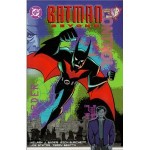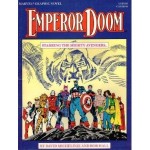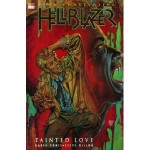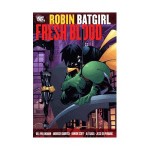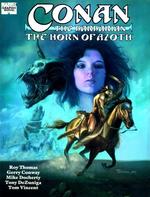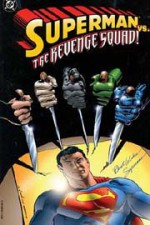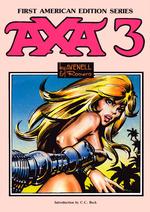
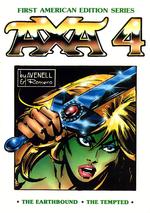
By Donne Avenell & Enrique Badia Romero (Ken Pierce Books)
Vol. 3 No ISBN: 0-912277-00-9Â Vol. 4 no ISBN: 0-912277-00-9
During the 1970s British newspapers radically altered much of their style and content to varying degrees in response to the seemingly inexorable move towards female social emancipation and sexual equality. Nevertheless, this somehow allowed newspaper editors to squeeze in even more undraped women, who finally escaped from the perfectly rendered comics strips and onto the regular pages, usually the third one, the centre-spreads and into the fashion features…
The only place where truly strong female role-models were taken seriously was the aforementioned cartoon sections but even there the likes of Modesty Blaise, Danielle, Scarth, Amanda and all the other capable ladies who walked all over the oppressor gender, both humorously and in straight adventure scenarios, lost clothes and shed undies repeatedly, continuously and in the manner they always had…
Nobody complained (no one important or who was ever taken seriously): it was just tradition and the idiom of the medium… and besides, artists liked to draw bare-naked ladies as much as blokes liked to see them and it was even educational for the kiddies – who could buy any newspaper in any shop without interference even if they couldn’t get into cinemas to view Flashdance, Trading Places, Octopussy or Spacehunter: Adventures in the Forbidden Zone without an accompanying adult…
Sales kept going up…
Take-charge chicks were almost commonplace when the Star Wars phenomenon reinvigorated public interest in science fiction and the old standby of scantily-clad, curvy amazons and post-apocalyptic wonderlands regained their sales-appeal. Thus The Sun hired Enrique Badia Romero and Donne Avenell to produce just such an attention-getter for their already well-stacked cartoon section.
Romero had begun his career in Spain in 1953, producing everything from westerns, sports, war stories and trading cards, often in conjunction with his brother Jorge BadÃa Romero. He even formed his own publishing house. “Enric†began working for the higher-paying UK market in the 1960s on strips such as ‘Cathy and Wendy’, ‘Isometrics’ and ‘Cassius Clay’ before successfully assuming the drawing duties on the high-profile Modesty Blaise strip in 1970 (see Modesty Blaise: The Hell Makers and Modesty Blaise: The Green Eyed Monster), only leaving when this enticing new prospect appeared.
In 1986 political and editorial intrigue saw Axa cancelled in the middle of a story and Romero returned to the bodacious Blaise until creator/writer Peter O’Donnell retired in 2001. Since then he has produced Modesty material for Scandinavia and a number of projects such as Durham Red for 2000AD.
Axa ran in The Sun Monday to Saturday from 1978 to her abrupt disappearance in 1986 and other than these slim volumes from strip historian Ken Pierce has never been graced with a definitive collection. It should be noted also that at the time of these books the strip was still being published to great acclaim.
In the first two volumes Axa, a pampered citizen of a sterile, domed community in 2080AD, rebelled against her antiseptic society’s cloying strictures and escaped to the ravaged, mutant-infested post apocalyptic wilderness to be free. Her journeys took her across the ravaged planet, discovering lost enclaves and encountering bizarre new tribes and cultures.
The third volume opens with an avid appreciation by C.C. Beck, the “Crusty Curmudgeon†most celebrated as co-creator of the Shazam!-shouting Captain Marvel before the nubile nomad resumed her explorations in ‘Axa the Brave’ with her latest companion Jason Arkady in tow. Crossing a frozen wasteland reclaimed by wolves after man’s Great Contamination excised human civilisation, the pair stagger into a lush tropical valley populated by dinosaurs and cavemen.
The historical anomalies are disturbing and dangerous enough, but when they were invited to join the new stone-agers they uncovered an even greater enigma: the cave-walls were covered in paintings of robots and weird machines… The secret of the hidden valley is yet another example of the brilliance and folly of the lost human civilisation and leads the unstoppable freedom-seeker to a swamp-city where an enclave of scientists had survived the disaster…
The hidden sages had a big plan to reshape the world and wanted Axa aboard, so they built her the perfect companion: a faithful, semi-sentient laser-wielding robot dubbed Mark 10 who instantly aroused the jealous ire of Jason. As so often the case however, Axa’s male benefactors had hidden plans for her but the scientists had built too well and the utterly devoted Mark came rattling rapidly to her rescue…
In ‘Axa the Gambler’ the winsome wanderer, with Mark and Jason faithfully following, stumbled onto a community where wagering was the basis for existence and pilgrims came from miles around to bet with the fervour of religious zealots.
In The City of Hope patrons worshipped Las Vegan relics, seeking instant gratification for their greedy, hungry prayers. Soon Jason had caught the bug and gambled away all their meager possessions including the magnificent ancient sword Axa had carried since her first escape from the Domed City.
Of course the game was fixed, but with Mark’s cybernetic intervention Axa recouped all their losses, narrowly escaping the hidden penalty that underpinned the barter-economy of the City: when you don’t have any more goods to wager with, you become the property of the house…
When Jason discovered a historic family link to big boss Mr. Nero he switched allegiance and Axa ended up fighting for her life and liberty in the gladiatorial arena beside motorcycle warrior Dirk. With freedom her greatest love, Axa inevitably engineered Nero’s bloody fall, but lost Jason to the lure of greed and an idle life of pleasure…
Axa 4 begins with an appreciation and “previously on…†by publisher Bernie McCarty before ‘Axa the Earthbound’ saw the blonde bombshell and Dirk hunting the missing mechanical Mark 10 through a haunted, monster-haunted swamp until they stumbled upon a lost oasis of beauty – a veritable paradise amidst the ruins of the world.
In a ramshackle old house lived aged Joy Eden who happily welcomed the wanderers to stay. Axa was subtly drawn to the aged free spirit’s talk of Mother Earth and pagan renewal but Dirk had his suspicions: did the old lady thrive despite the mutants and mud-monsters… or because of them?
Deeply steeped in Earth-magic and transformative mysticism, did the lonely old crone have another reason for keeping Dirk and Axa within the tumbledown walls of her “Seventh Heavenâ€â€¦ and just what did happen to the coldly technological but absolutely loyal Mark?
Ending as always in bitter revelation, chilling conflict and spectacular conflagration the denouements led the explorers back into the desert wastes in ‘Axa the Tempted’. Their trek brought them to the coast where mutated seaweed and giant sea-life threatened to end their trials for ever and whilst fleeing giant land-crustaceans the couple found an ancient beached ocean-liner from where inbred pirates raided other coastal settlements for slaves, provisions and “Old People†technological artifacts.
Escaping from “The Crewmenâ€, Axa and Dirk allied themselves with the united sea-villagers and the heroic Cap, King of the Coast, who protects the scattered communities from pirate depredations. The wily wild-girl was strangely attracted to the larger-than-life champion and his luxurious life of adventure, excitement and bold deeds, but Dirk had mysteriously vanished and something just didn’t ring true about the magnanimous warrior-king…
Once more bitter disappointment and righteous indignation awaited Axa as she once more learned that no matter where she roamed men were all the same whilst greed and depravity had not vanished with the Old Ones and their Great Contamination.
These tales are superb examples of the uniquely British newspaper strip style: lavishly drawn, subversively written, expansive in scope and utterly enchanting in their basic simplicity – with lots of flashed flesh, emphatic action and sly humour. Eminently readable and re-readable (and there’s still that dwindling promise of a major motion picture) Axa is long overdue for a definitive collection. so here’s hoping there’s a bold publisher out there looking for the next big thing…
© 1983 Express Newspapers, Ltd. First American Collectors Edition Series ™ & © 1983 Ken Pierce, Inc.


